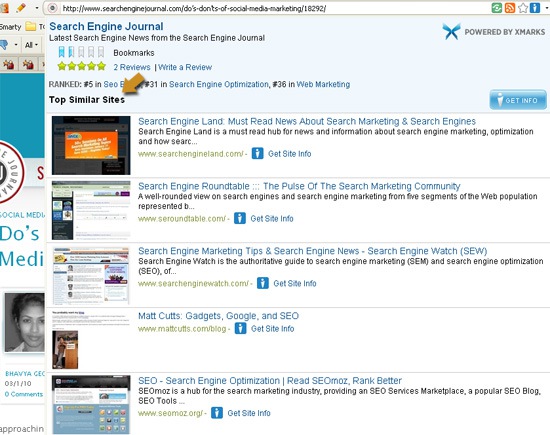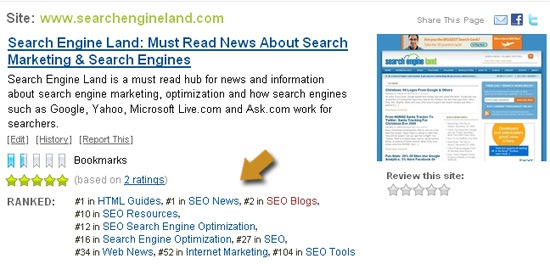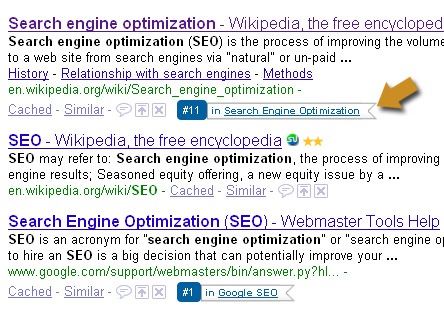"Search Engine Journal" - 7 new articles
- Facebook Searches Grow by 10% in February
- YouTube Mobile Now Serving Banner Ads
- Google Adds Biking Directions to Maps
- Be "Real" With Your Customers
- Your Online Retirement
- Find Relevant Blogs (and Link Building Opportunities) with Xmarks
- Google Opens Apps Marketplace for Business
- More Recent Articles
- Search Search Engine Journal
Facebook Searches Grow by 10% in February
ComScore has just released its February search engine rankings data. And while there's nothing new in terms of who is on top, who gained and who lost, what's surprising about it is that among all the online properties where searches are conducted other than the five major search engines, Facebook gained a significant amount of searches in February.
Yes, it seems that more search activities are happening on Facebook lately. Facebook's total search queries may not be that significant compared to the top search engines, but then it was only the online property which registered search query growth in February – amounting to 10% increase from its January search market share. Total searches conducted on Facebook was 436 million while Google got 13.5 billion search queries, Yahoo got 2.5 billion and Microsoft sites got 1.7 billion searches.
In terms of Core Searches though, Facebook is nowhere near the top five search engines where Google stays on top of the pact with 65.5% of searches, Yahoo with 16.8% and Microsoft Sites with 11.5%. Both Google and Microsoft had a slight increase in search market share in February with 0.1% and 0.2% respectively.
Total searches in the U.S. amounted to 14.5 billion which is a slight 5% decrease compare with data in January. Google Sites got 9.5 billion of these searches, Yahoo got 2.5 billion and Microsoft 1.7 billion.
Check out the SEO Tools guide at Search Engine Journal.
Facebook Searches Grow by 10% in Februaryalquileres madrid alquileres barcelona tecnologías malasia videncia aceite sexualidad tecnologías
YouTube Mobile Now Serving Banner Ads
With the ever growing site traffic of of YouTube mobile site, it is not surprising that Google will take advantage of this to serve advertisements. In 2009, YouTube mobile's site traffic increased by 160%. You can just imagine how good this site traffic will be in terms of potential for more ad clicks and brand campaign awareness.
So, YouTube has started serving ads, particularly banner ads on its mobile site's home, search and browse pages. This is being rolled out to American and Japanese YouTube mobile websites, that is – m.youtube.com on your mobile phone's browser.
According to Google, this is a great way for advertisers to reach YouTube viewers across multiple platforms. But for us users, this could become pretty annoying and additional data costs if we're not on an unlimited mobile data plan. It's a good thing if there's always free Wi-Fi around.
But then, who are we to complain, right? After all, YouTube videos are free to consume. So, expect more banner ads from the likes of Sony, Kia and the others the next time you browse for the latest sensation on YouTube video. Hopefully, the ads won't annoy you enough to look for an alternative mobile video site.
If you're a brand campaign manager, you ought to know that those banner ad spots are sold on a full-day basis. You can extend your ad campaign run from the YouTube website to the mobile site. To know how you can go about this, visit this site.
Check out the SEO Tools guide at Search Engine Journal.
YouTube Mobile Now Serving Banner Ads

Google Adds Biking Directions to Maps
While you are pondering on the points made by Todd about online retirement, here's a worthwile albeit healthy activity that you may want to consider – biking. And to help you navigate your way through U.S. cities on your bike, Google has just added useful biking directions and bike trail data to Google Maps.
Google has been gathering these bike trail data for quite some time now and now that they've gathered as much data as possible, these biking directions are now part of the Google Maps interface. These biking directions provide efficient routes and allow you to customize your trip, make use of designated bike lanes, calculate rider-friendly routes as well as customize the look of the Google Maps to suit cycling activities.
Google has also added information about bike trails, lanes, and recommended roads directly onto Google Maps. This will help you get better sense of route and trails worth traversing if you're into recreational ride. You can check out the bicyling layer on the "more" button at the top of a Google Map. This layer has three types of lines – dark green for dedicated bike-only trail, light green for a dedicated bike lane along a road and dashed green for roads recommended for biking but has not bike trail.
Google Maps currently has more than 12,000 miles of bike trails, and bike lane data for 150 U.S. cities. You may check out Google Maps biking directions here.
Check out the SEO Tools guide at Search Engine Journal.
Google Adds Biking Directions to Maps
Be "Real" With Your Customers
A lot of today's top copywriters got their start in direct mail, broadcasting and catalog pieces. Back then, the medium was strictly rooted in the "Push" era – we shovel out the content, you take it all in and buy this widget.
When the web started coming of age, people realized that they didn't have to "take it all in" – they could comparison shop, read reviews and judge ratings. Even in the last few years we've gained the ability to ask friends, groups and followers for their thoughts and recommendations over social networks and get the answers we need almost instantly wherever we are.
The "Push" Era is over. But the Share Era is just getting started.
The question is – is your content keeping up with the times?
So many sales letters on the web are still crafted the "old fashioned way" – they assault your eyes with huge red fonts and bright yellow highlighters (all probably stemming from what some direct mail copywriter swore worked like magic back in the 1960's). They do nothing but push, push, push – and hope that they'll sound like an authority long enough for you to grab your credit card and order.
Don't Write "At" Your Readers – Write "To" Them
The best way to get in on this gigantic wave of share marketing is to explain your product or service to your reader as if they were sitting in the room with you now. Grab a tape recorder and record yourself – since you'll talk very differently than you write. Don't be afraid to "be yourself" either – be enthusiastic and excited about your offer.
If your product or service is truly as great and as helpful as you believe it is, this will come through in your voice – and in your writing. These are the kinds of "real life" tidbits you want to include. Not hype, not fluff, but believability and sincerity. Throw out the larger-than-life, stiff suit you and let people see the real you.
Don't worry about what they'll think – because your visitors, subscribers and customers are people just like you. If you're afraid of turning people away by "being yourself" – that's good. Those people would've likely gone elsewhere anyway. Let them go. Focus on the ones that stay – those are your real fans.
"You're Just Like Me!"
Take a good, strong look at your copy. Clear out anything that smacks of temptation, manipulation or arm-twisting persuasion. You don't need it. What you do need – as I've seen happen time and time again for truly great products, is enough strength to say "I've tried this, and it really helped me. Here's how I did it and here's why I think you'll like it too…"
Make that person reading your copy exclaim, "Hey! You're just like me!" And being able to reach people on that kind of "real life" level is something that no bright red font or yellow highlighter can ever match!
Sherice Jacob helps site owners improve website performance and increase conversions through her blog and custom design service at iElectrify. You can also follow @sherice on Twitter for more big bangs of inspiration and design coolness.
Check out the SEO Tools guide at Search Engine Journal.
Be "Real" With Your Customers
Your Online Retirement
"Burningly it came on me all at once,
This was the place! those two hills on the right,
Crouched like two bulls locked horn in horn in fight;
While to the left, a tall scalped mountain… Dunce,
Dotard, a-dozing at the very nonce,
After a life spent training for the sight!"
Robert Browning "Childe Roland To The Dark Tower Came"
I'm sure you've all heard it before. Work hard your entire life while putting aside a portion of your earnings to fund your post-career retirement (supplemented by Social Security / Medicare or their non-US equivalents). Part of that advice is still good, since our laws are written in such a way as to make it foolhardy not to participate in these government programs. Plus saving as much money as possible is always a good strategy as a hedge against an uncertain future (and your heirs will love you for it).
But retirement from online efforts when they are successful? Yeah, right. Cut back on the time spent online? Perhaps. However, instead of retiring from online, may I suggest instead…Online Retirement.
In our online careers, many of us have played different roles and worked different projects. Over time, we've gravitated towards things that are both enjoyable and lucrative to us. We've sold our expertise by the hour as consultants or salaried employees but if we're smart, we've also invested our time in developing our own online revenue streams (e.g. Affiliate Marketing) or acquired / developed assets (e.g. domain names, fully developed websites) that will appreciate in value over time as we get closer to the Government's definition of "retirement age".
Our online abilities that we've established and the online assets that we own / developed have become major components of our online identity which is how we're known by others. We take that identity into every interaction & encounter we have with someone since our persona is immediately discoverable with a simple Google Search. An active online identity is the catalyst for building and developing valuable and meaningful relationships with others which can be leveraged for any and all present and future initiatives we might want to take.
Let's also not forget how the distinctions between work and non-work online have been permanently blurred. Sure, we need to spend enough time online doing "productive" pursuits in order to support ourselves, but that should still leave plenty of time to have a little fun too. Social media is a wonderful catalyst for that. Connect business relationships with social media and the relationships can become personal. Connect personal relationships with social media and the relationships can become business. Strangers become friends. Strangers become clients. Friends become clients. Clients become friends. We're all accessible 24/7…work time and leisure time folding together as we live our lives online.
And we're supposed to retire from this life?
Most everyone reading this blog post is profoundly blessed that they are earning their living via a medium that is not only ubiquitously accessible and continually enjoyable but transcends any cultural, social, generational & class boundaries. The concept of retirement is totally inapplicable to our collective lifestyles. Over time, our online lives will and at some point, some of us might not favor the direction of the online evolution and quit surfing along the cutting edge. However, even when those particular folks get off the bus, there will remain pleasurable and lucrative inhabitable niches for them where they can park themselves and prosper.
Remember, there is an online component to every offline activity…so whatever activities take up your time in your golden years, there is an online community that will welcome your participation and leadership.
Check out the SEO Tools guide at Search Engine Journal.
Your Online Retirement
Find Relevant Blogs (and Link Building Opportunities) with Xmarks
Xmarks is one of those FireFox plugins that I've been using for ages. I mentioned it in my one of the first FireFox tool overviews and I still find it awesome.
With some (arguably) great "social" features added Xmarks has turned a cool search engine as well. I find it quite relevant and precise. Sure, the database is not as huge as Google's but what it currently has is the best of the best.
Xmarks search feature is based on its users' preferences:
- The rank of each site is defined by how many people bookmarked the page;
- The topic if the site is defined by the tags a surfer used to save the page.
Additionally, with the most recent update, Xmarks developers have introduced extra ratings and reviews from the FireFox status bar.
Thus, run by people, the tool is still amazingly precise.
Here's how you can use it to locate relevant blogs in your niche (and possibly consider them as link targets);
Find more "similar" sites
Most of us are aware of most popular blogs in each niche. But to find more blogs on the same topic is not that easy.
Well, Xmarks gives you such a possibility: just go to the site and search for the blog domain.
If you are using the addon, you can see similar sites right from the status bar icon (just right-click it):
The report will load quietly in the foreground and will look like this:
By clicking "Get info" tab you'll be taken to the full report online.
Search by tags
The detailed site report will also include all the tags people were using to organize the bookmark. You will also be able to see where the current site ranks for each tag.
The next thing you can do is to browse those tags to see more sites (and more tags!):
Enjoy enhanced Google search results
Xmarks search integration also looks cool to me (much better than any other "social" help to SERPs I would say).
All it does basically is integrating its icon within Google SERPs for you to see that site rankings in Xmarks system and its main tag:
You can thus start your link-building research right from regular Google search.
Check out the SEO Tools guide at Search Engine Journal.
Find Relevant Blogs (and Link Building Opportunities) with Xmarks
Google Opens Apps Marketplace for Business
I pretty much remember when talks about Google launching its own store for web apps started circulating before. But Google remained mum about it until now. The Google Apps Marketplace has been launched and is now open for business.
So what's this all about really? According to the Official Google Blog, the Google Apps Marketplace is a new online store for integrated business apps. It will allow Google Apps customers to easily discover, deploy and manage cloud apps that will easily integrate with Google Apps. The apps currently available on the Marketplace are installable apps that are easy because of single sign-on, universal navigation and integration with domain's data.
The Apps Marketplace currently has more than 50 companies selling apps such as Intuit Online Payroll, Manymoon, Professional Services Connect (PS Connect), JIRA Studio among other online business apps.
Once any of these apps are installed on a company's domain, they will work like native Google apps and can interact with calendar, email, document and contact data. These apps can be managed through Google Apps control panel by enterprises web administrator and opened by company employees within Google Apps.
Of course, these apps support OpenID integration or single sign-on. So you don't have to login for several times just to use individual apps.
Check out the SEO Tools guide at Search Engine Journal.
Google Opens Apps Marketplace for Business
More Recent Articles

Your requested content delivery powered by FeedBlitz, LLC, 9 Thoreau Way, Sudbury, MA 01776, USA. +1.978.776.9498
jueves, 11 de marzo de 2010
Suscribirse a:
Enviar comentarios (Atom)
Seguidores
Archivo del blog
-
▼
2010
(127)
- ► septiembre (7)
-
▼
marzo
(36)
- <!-- AOL_MESSAGE --><!-- Your FeedBlitz Updates ...
- <!-- AOL_MESSAGE --><!-- Your FeedBlitz Updates ...
- <!-- AOL_MESSAGE --><!-- Your FeedBlitz Updates ...
- <!-- Centro de Información WPERU --><!-- ...
- <!-- AOL_MESSAGE --><!-- Your FeedBlitz Updates ...
- <!-- AOL_MESSAGE --><!-- Your FeedBlitz Updates ...
- <!-- AOL_MESSAGE --><!-- Your FeedBlitz Updates ...
- Del iPhone al iPad
- <!-- AOL_MESSAGE --><!-- Your FeedBlitz Updates ...
- <!-- AOL_MESSAGE --><!-- Your FeedBlitz Updates ...
- Best-ever Freeware"
- <!-- AOL_MESSAGE --><!-- Your FeedBlitz Updates ...
- <!-- AOL_MESSAGE --><!-- Your FeedBlitz Updates ...
- <!-- AOL_MESSAGE --><!-- Your FeedBlitz Updates ...
- <!-- Carrero» , Carrero. David Carrero y Jaime C...
- <!-- AOL_MESSAGE --><!-- Your FeedBlitz Updates ...
- <!-- AOL_MESSAGE --><!-- Your FeedBlitz Updates ...
- - 10 new articles
- <!-- AOL_MESSAGE --><!-- Your FeedBlitz Updates ...
- <!-- Carrero» , Carrero. David Carrero y Jaime C...
- <!-- Blog de informatica --><!-- ...
- <!-- AOL_MESSAGE --><!-- Your FeedBlitz Updates ...
- <!-- AOL_MESSAGE --><!-- Your FeedBlitz Updates ...
- <!-- AOL_MESSAGE --><!-- Your FeedBlitz Updates ...
- A Time and Season for Search: How Data Mining Can...
- <!-- Carrero» , Carrero. David Carrero y Jaime C...
- <!-- Carrero» , Carrero. David Carrero y Jaime C...
- <!-- Carrero» , Carrero. David Carrero y Jaime C...
- Watch the 2010 Oscars : Academy Awards Online
- Google Buys Online Collaboration Operator DocVerse
- <!-- AOL_MESSAGE --><!-- Your FeedBlitz Updates ...
- <!-- Carrero» , Carrero. David Carrero y Jaime C...
- <!-- Carrero» , Carrero. David Carrero y Jaime C...
- <!-- AOL_MESSAGE --><!-- Your FeedBlitz Updates ...
- Twitter Newsletter 2010 - Edition #1
- <!-- AOL_MESSAGE --><!-- Your FeedBlitz Updates ...












No hay comentarios:
Publicar un comentario